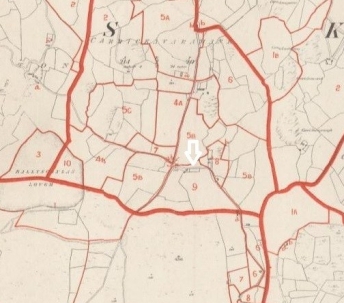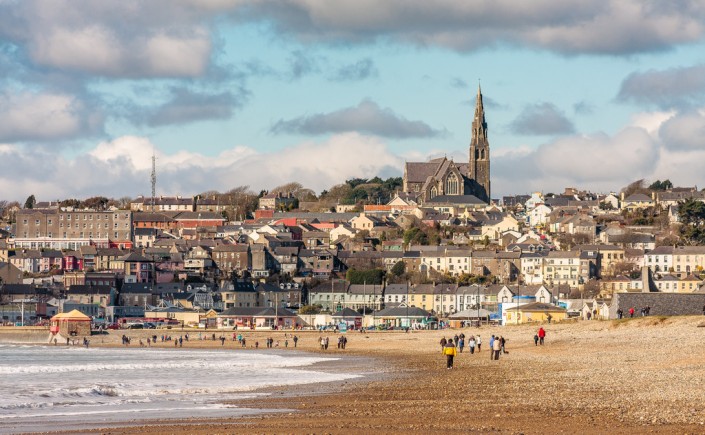Pierse Flahavan, a client’s great-great-grandfather, was born in about 1826 in the tiny “townland” of Carrickavarahane, located in the Civil Parish of Reisk, County Waterford, Ireland. The townland is about three miles northwest of the center of Tramore, on the southeastern coast of Ireland. Tramore at the time of Pierse’s birth was a small, sleepy fishing village. Pierse’s father’s name was Philip, and his mother’s name was Catherine Power. Pierse had at least three siblings, Maurice (probably born before 1829), Jacob (born in 1829), and Ellen or Eleanor (born in 1832). Early records note their name as “Flavahan”, which morphed into “Flahavan” in the late 1850s, and then the name changed again to Flavin (both in Ireland and America) a little before the turn of the 20th century.

Baptismal Record, in Latin, of “Jacobum” (Pierse’s brother), son of “”Philipi Flavahan & Cath. Power”

Baptismal Record of “Ellonoram” (Pierse’s sister), daughter of “Philipi Flavahan & Cath. Power”
The Flahavan family was Catholic, like the vast majority of families living in County Waterford. They would have walked to a local church in Carrickavarahane or another nearby community to attend mass at least once a week.

Note plot 9, Philip Flavahan, Griffith’s Valuation, 1853, for Carrickavarahan (used with permission, http://www.askaboutireland.ie)

Griffith’s Valuation map, 1853, Philip Flavahan leased plot #9 (used with permission, http://www.askaboutireland.ie).
Records from 1853 (Griffith’s Valuation), right after the Irish Potato Famine, indicate that Pierse’s father Philip leased 24 acres. Like most of his neighbors, he would have been considered a small farmer. We also know from later court records that he grew cabbage and barley, and it was likely that he grew potatoes and other vegetables as well.
Reports written in the mid- to late 1830’s (less than a decade before the Great Famine) describe in detail some of the counties of Ireland. Unfortunately, County Waterford is not included. However, the reports are instructive in their descriptions of the peasant population. A typical description in one of the reports describes the “Habits of the People” as follows: “Their habits are bad, being very much addicted to whiskey and party fights. Their houses are of limestone but very little of it is expended in white-washing the cabins either inside or out. The cow, horse or ass lives in the same room with the family, and dirt and filth are the common characteristics of their dwellings. In this state of things, some drag out existence for 100 or more years. They do not marry very early.” While these words were written by an Englishman, and it is clear that the English had nothing but contempt for their Irish subjects, the words are likely an accurate description of peasant life.
And these words were written prior to the Famine (1845 – 1852). One can only imagine the suffering that a typical Irish peasant would have endured during that crisis. Pierse’s family, one could easily speculate, probably lost at least one member, possibly more, during the Famine, due to starvation or disease. While Pierse obviously survived, the crisis would have certainly had a profound impact on him, occurring during his young adulthood when he was roughly 19 – 26.
Marriages were often delayed during the Famine, when people were concentrating on mere survival. And Pierse’s marriage may have been delayed. He got married at the age of 29 in 1855. His wife, my client’s great-great-grandmother, was named Mary Murray. She was 19 at the time of their marriage and her family lived about two miles away in the neighboring “townland” of Munmahoge. Her father’s name was also Pierce, oddly, since it is not a common name. He was also a small farmer, leasing about 13 acres in 1853.
After Pierse and Mary’s marriage, it is clear from court records that they then lived in Munmahoge, likely in the house or at least on the property initially leased by Mary’s father, Pierce Murray.
Pierse and Mary Flahavan were the parents of five children:
Philip J (my client’s great-grandfather), born Jan 1858, emigrated to Massachusetts in 1880;
Catherine, born 1863, emigrated to Massachusetts between 1880 and 1885;
Michael J, born 1864, emigrated to Massachusetts about 1885;
Margaret M, born 1866, emigrated to Massachusetts about 1886;
And probably a daughter named Mary, birth year unknown but before 1864, stayed behind in Ireland.
It is clear that life for the Flahavan family in Carrickavarahane and Munmahogue was not easy. Court records indicate that both father Philip and son Pierse, as well as other members of the extended Flahavan clan, had many disputes with neighbors and other members of the community, and they were also likely well-known to the local authorities. Records of the Petty Session Courts in Tramore reveal a total of 13 disputes and citations involving father Philip and son Pierse over the years, for everything from “allowing 15 geese to trespass on neighbor’s property” for which Philip was ordered to pay 2 shillings, 6 pence, plus 1 shilling court costs, to a citation against Pierse for having an unlicensed dog, to a citation against Pierse for “appearing drunk in public at Tramore,” for which Pierse was ordered to pay 2 shillings, 6 pence, plus 1 shilling court costs.

A typical Petty Sessions Court record from 1883 where Pierse, the defendant, was sued for allowing two goats and one ass to trespass on a neighbor’s property and ordered to pay 6 pence, plus 1 shilling court costs

The Petty Sessions were the lowest courts in 19th century Ireland. They handled both criminal and civil matters, many extremely petty in nature. The court rooms were crowded, loud and hot, drawing criticism from many, including the legal professionals handling the cases. Magistrates were usually from the Protestant landowning class (from http://www.findmypast.com).
To be continued . . .
Sources: Baptismal Records of Jacobum Flavahan and Ellonoram Flavahan:
Catholic Parish Registers, The National Library of Ireland; Dublin, Ireland; Microfilm Number: Microfilm 02448 / 03; Ireland, Catholic Parish Registers, 1655-1915; Ancestry.com; Ancestry.com Operations, Inc.; 2016; Provo, UT.
Griffith’s Valuation, Townland of Carrickavarahane, Parish of Reisk, County Waterford, Ireland, http://www.askaboutireland.ie.
Griffith’s Valuation, Townland of Munmahoge, Parish of Kilburne, County Waterford, Ireland, http://www.askaboutireland.ie.
Ordinance Survey, Memoirs of Ireland: Counties of South Ulster 1834-8, Vol 40; Edited by Angelique Day and Patrick McWilliams; The Institute of Irish Studies, The Queen’s University of Belfast; 1998; Reprinted by Ulster Historical Foundation, 2006, pg. 53.
A Brief History of Ireland: Land, People, History; Richard Killeen; Running Press; Philadelphia, PA; 2012.
Mary Flavin, 1900 Census: Year: 1900; Census Place: Greenfield, Franklin, Massachusetts; Roll: 648; Page: 16B; Enumeration District: 0480; FHL microfilm: 1240648, 1900 United States Federal Census, Ancestry.com, Ancestry.com Operations, Inc., 2004, Provo, UT.
Philip Flahavan, Catherine Flahavan, Margaret Flahavan Marriage Records:
Massachusetts, Marriage Records, 1840-1915, Ancestry.com, Ancestry.com Operations, Inc., 2013, Provo, UT.
Michael Flahavan Birth Record:
“Ireland Births and Baptisms, 1620-1881,”
database, FamilySearch (https://familysearch.org/ark:/61903/1:1:F52L-NJR : accessed 10 October 2015), Pierse Flahavan in entry for Michael Flahavan, 24 Sep 1864; citing 0876, Tramore, Waterford, Ireland.
Philip J Flahavan Ship Passenger Record: Year: 1880; Arrival: New York, New York; Microfilm Serial: M237, 1820-1897; Microfilm Roll: Roll 426; Line: 18; List Number: 591, New York, Passenger Lists, 1820-1957, Ancestry.com, Ancestry.com Operations, Inc., 2010, Provo, UT. Michael Flavin Census:
Year: 1910; Census Place: Greenfield, Franklin, Massachusetts; Roll: T624_588; Page: 9A; Enumeration District: 0501; FHL microfilm: 1374601, 1910 United States Federal Census, Ancestry.com, Ancestry.com Operations Inc, 2006, Provo, UT.
Margaret Finn Census:
Year: 1910; Census Place: Greenfield, Franklin, Massachusetts; Roll: T624_588; Page: 9A; Enumeration District: 0501; FHL microfilm: 1374601, 1910 United States Federal Census, Ancestry.com, Ancestry.com Operations Inc, 2006, Provo, UT.
All Irish Petty Sessions Registers records from http://www.findmypast.com.
Pierce Flavan, 1901 Census: National Archives of Ireland, http://www.findmypast.com.
Catherine Flavin Campell and Mary Murray Flahavan Death Records:
Massachusetts, Death Records, 1841-1915, Ancestry.com, Ancestry.com Operations, Inc., 2013, Provo, UT.
Mary Flavin, 1900 Census: Year: 1900; Census Place: Greenfield, Franklin, Massachusetts; Roll: 648; Page: 16B; Enumeration District: 0480; FHL microfilm: 1240648, 1900 United States Federal Census, Ancestry.com, Ancestry.com Operations Inc., 2004, Provo, UT, USA.
Philip Flahavan 1900 Census:
Year: 1900; Census Place: Concord, Middlesex, Massachusetts; Roll: 658; Page: 2A; Enumeration District: 0736; FHL microfilm: 1240658, 1900 United States Federal Census, Ancestry.com, Ancestry.com Operations Inc, 2004, Provo, UT.


[…] mentioned in Part I, Pierse and Mary Flahavan were the parents of five […]
LikeLike